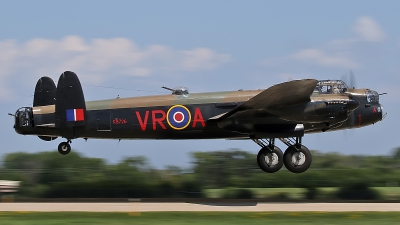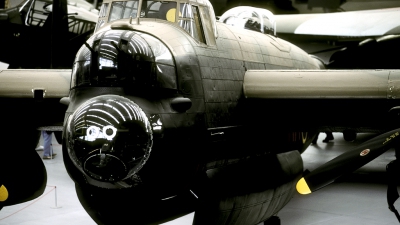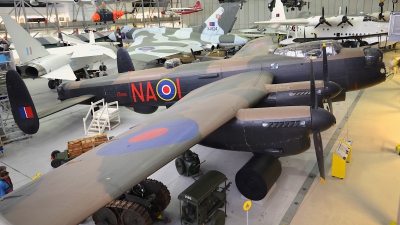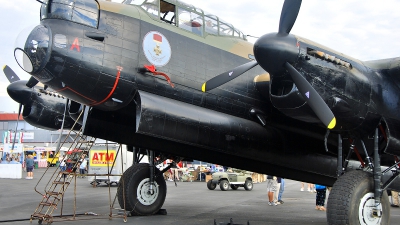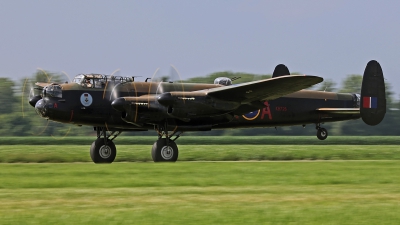Avro 683 Lancaster B.X Aircraft Data
As with the establishment of a Merlin production line with Packard Motors in the USA, the need for boosting Lancaster production resulted in the opening of a production facility in Canada. Victory Aircraft Ltd., of Malton, Ontario eventually produced 430 Lancaster B.IIIs, these aircraft were designated Lancaster B.X. The majority of the Canadian-built machines saw service in Europe, with units of the Royal Canadian Air Force (RCAF). After the end of hostilities, most of the surviving aircraft returned to Canada.
From 1946, a number of surviving Lancaster B.Xs were modified for continued service with the post-war Royal Canadian Air Force. These modifications resulted in a number of type/role designations. At around this time the type designations changed from the use of roman to arabic numerals and so the B.X became the B.10.
At least 68 Lancasters (some sources state 70 or even 70+) were modified for maritime patrol and reconnaissance duties as wel as anti-submarine patrols. These Lancasters were designated Lancaster 10MR. Modifications included the installation of radar and sonobuoy operators' positions, removal of the rear and mid-upper gun turrets, installation of a 400-gallon fuel tank in the bomb bay to increase the patrol range, upgraded electronics, radar, and instrumentation, and a cooking stove in the centre section. The Mk.10MR had a crew of 10. At a later stage, around 1956, the designation was changed to 10MP. The remaining aircraft served throughout the 1950s and were eventually replaced by Lockheed Neptunes and Canadair Argus aircraft.
Known conversions to Mk.10MR include: KB919 (Mk.10MR prototype), KB 857, 865, 871, 875, 882 (later converted to Mk.10PR), 927, 929, 934, 945, 948, 955, 956, 961, 964, 966, 967, 972, 974, 977, 992, 995, 997, 999 and the following in the FM-serial range: FM102, 110, 115, 128, 136, 159 (later converted to Mk.10SR), 172, 173, 210, 213, 223, 224, 225, 226, 227, 228 and 229.
In 1956 the type designation changed to Mk.10MP. Known aircraft with the this designation included: KB8680, 883, 890, 892, 893, 894, 901, 903, 904, 917, 920, 925, 937, 943, 946, 949, 950, 957, 958, 959, 960, 965, 973, 996 and the following aircraft in the FM-serial range: FM140, 219 and 220.
Fourteen aircraft were modified to Mk.10PR (PhotoReconnaissance) for aerial survey and photo-reconnaissance missions: FM212, the prototype Mk.10PR, KB882, 884, 889, FM120, 122, 199, 207, 208 (later converted to Mk.10N), 214, 215, 216, 217 and 218. These aircraft were initially in service with No.413 Squadron, but from 1950 this task was taken over by No.408 Squadron at Rockcliffe, Ottawa, Ontario. The squadron's role was later expanded to include area reconnaissance, for which it received three Mk.10AR conversions: KB839, KB954 and KB976.
The unit's survey flights and the mapping of the Arctic of northern Canada continued until as late as 1964.
At least eight Lancasters were modified for search and rescue (Air Sea Rescue) as Lancaster Mk.10SR: KB907, 944, 991, FM104 (converted from a Mk.10MR, later reconverted to Mk.10SR and finally becoming a Mk.10MP), FM148, FM159, 221, 222.
Of these, four were later modified for bomber-reconnaissance work as Mk.10BR: KB991, FM221 (prototype Mk.10BR) and two others.
Two aircraft were modified for carrying and launching of Ryan KDA-4 Firebee drones. These two aircraft, KB848 and KB851 were designated Mk.10DC, although some sources state this version as Mk.10DR.
Five Mk.10s were converted Mk.10N navigation trainers for use with the No.1 Air Navigation School, succeeded by the Central Navigation School at Summerside, Prince Edward Island: KB986 (for use as a spare aircraft), KB826 'Orion', FM206 'Northern Cross', FM208 'Polaris' (converted from Mk.10P) and FM211 'Zenith'.
Lancaster B.X production:
The Lancaster B.X was produced by Victory Aircraft Ltd., Malton, Ontario, Canada. The first production batch consisted of 300 aircraft, with serials from KB700 to KB999. These aircraft were delivered between September 1943 and March 1945. Of the second order for 200 aircraft only 130 were completed. The aircraft with serials from FM100 to FM229 were delivered between April 1945 and August 1946.
Engines for the Lancaster B.X:
The first 75 B.Xs (KB700-774) had four Rolls Royce Merlin 38 two-speed, single stage engines of 1,390 hp (1,036 kW) each. All subsequent aircraft in the KB-serial range were equipped with four Packard Merlin 224 engines (1,640 hp/ 1,223 kW).
Surviving Lancaster B.X
Today only a handful of Lancaster B.Xs survive, with only one airworthy example: FM213 with the Canadian Warplane Heritage at Hamilton, Ontario, Canada. The flagship of the CWH is in the colours of Lancaster B.X KB726 'VR-A' of No.419 (Moose) Squadron, RCAF. In the night of 12/13 June 1944, a week after the D-Day landings in Normandy, her crew, on their 13th operation, had reached the target around midnight. There they were engaged by searchlights and flak and a short time later the Lancaster was attacked by a Junkers Ju 88 night fighter over Cambrai. Raked by cannon fire with major strikes on the port engines and centre fuselage, a hydraulic fire engulfed the bomber. Losing both port engines, the captain F/O De Breyne ordered the crew to bail out. As WO2 Andrew Charles Mynarski approached the rear escape door, he saw that tail gunner P/O Pat Brophy was trapped in his jammed turret. Mynarski made his way through the flames to Brophy's turret. All his efforts were in vain. With Mynarski's flight suit and parachute on fire, Brophy eventually waved him away. Mynarski crawled back through the hydraulic fire and jumped through the rear escape hatch out of the doomed Lancaster.
Except for P/O Brophy, all other crew members of the Lancaster managed to escape the burning bomber. Brophy however, miraculously survived when the Lancaster hit the ground and he was thrown clear.
Mynarski landed alive, though severely burned, with his clothes still on fire. French farmers who spotted the flaming bomber found him and took him to a German field hospital but he died shortly afterwards of severe burns.
Andrew Charles Mynarski was buried in the Commonwealth War Graves Commission plot in the Méharicourt Communal Cemetery, near Amiens, France.
On 11 October 1946, a Victoria Cross was posthumously awarded for "valour of the highest order" to Andrew Charles Mynarski, and by then also awarded the rank of Pilot Officer.
For a short period in 2016, the port side of FM213 was repainted in the wartime markings of KB895, 'Lady Orchid' of 434 (Bluenose) Squadron, RCAF, coded 'WL-O'. The centre section of KB895 was used in the restoration of FM213.
Preserved Lancaster B.X:
Canada
Apart from FM213, several other Lancaster B.Xs are preserved in Canada:
FM104 at the British Columbia Aviation Museum at Sydney, Vancouver Island, British Columbia possibly for restoration to airworthy condition. This aircraft had previously been on display in the Canadian National Exhibition Grounds, Toronto, Ontario.
FM212 is under restoration by the Canadian Historical Aircraft Association in the City of Windsor, Ontario.
FM136 in the Calgary Aerospace Museum, Calgary, Alberta. On display in the colours of ‘Lady Orchid’, WL-O', as worn by KB895, 434 Squadron. This aircraft was previously displayed as ‘R5689/VN-N’, 50 Sq.
FM159 by the Nanton Lancaster Society Museum, Nanton, Alberta. On display in 617 Squadron c/s, coded 'AJ-M', as flown by F/L John Hopgood during the famous Dams raid.
KB839 at CFB Greenwood, Nova Scotia. The aircraft has been restored to wartime condition and has been repainted in a standard Bomber Command schema, representing Lancaster JB226 of 405 Squadron.
KB882 at the National Air Force Museum of Canada at Trenton, Ontario. This aircraft came on 4 October 2017 from St. Jacques Airport, Edmunston, New Brunswick, were it had been on display.
KB944 at the National Aviation Museum/National Aeronautical Collection, Ottawa, Quebec, in 428 (Ghost) Squadron c/s, as 'Winnie', coded 'NA-P'.
United States of America
In the United States of America, Kermit Weeks has KB976 (ex G-BCOH) in store.
United Kingdom
At the Imperial War Museum at Duxford, Lancaster B.X KB889 is preserved and is on display in "AirSpace" in the colours of 428 (Ghost) Squadron, RCAF, with her wartime code 'NA-I'.
From 1946, a number of surviving Lancaster B.Xs were modified for continued service with the post-war Royal Canadian Air Force. These modifications resulted in a number of type/role designations. At around this time the type designations changed from the use of roman to arabic numerals and so the B.X became the B.10.
At least 68 Lancasters (some sources state 70 or even 70+) were modified for maritime patrol and reconnaissance duties as wel as anti-submarine patrols. These Lancasters were designated Lancaster 10MR. Modifications included the installation of radar and sonobuoy operators' positions, removal of the rear and mid-upper gun turrets, installation of a 400-gallon fuel tank in the bomb bay to increase the patrol range, upgraded electronics, radar, and instrumentation, and a cooking stove in the centre section. The Mk.10MR had a crew of 10. At a later stage, around 1956, the designation was changed to 10MP. The remaining aircraft served throughout the 1950s and were eventually replaced by Lockheed Neptunes and Canadair Argus aircraft.
Known conversions to Mk.10MR include: KB919 (Mk.10MR prototype), KB 857, 865, 871, 875, 882 (later converted to Mk.10PR), 927, 929, 934, 945, 948, 955, 956, 961, 964, 966, 967, 972, 974, 977, 992, 995, 997, 999 and the following in the FM-serial range: FM102, 110, 115, 128, 136, 159 (later converted to Mk.10SR), 172, 173, 210, 213, 223, 224, 225, 226, 227, 228 and 229.
In 1956 the type designation changed to Mk.10MP. Known aircraft with the this designation included: KB8680, 883, 890, 892, 893, 894, 901, 903, 904, 917, 920, 925, 937, 943, 946, 949, 950, 957, 958, 959, 960, 965, 973, 996 and the following aircraft in the FM-serial range: FM140, 219 and 220.
Fourteen aircraft were modified to Mk.10PR (PhotoReconnaissance) for aerial survey and photo-reconnaissance missions: FM212, the prototype Mk.10PR, KB882, 884, 889, FM120, 122, 199, 207, 208 (later converted to Mk.10N), 214, 215, 216, 217 and 218. These aircraft were initially in service with No.413 Squadron, but from 1950 this task was taken over by No.408 Squadron at Rockcliffe, Ottawa, Ontario. The squadron's role was later expanded to include area reconnaissance, for which it received three Mk.10AR conversions: KB839, KB954 and KB976.
The unit's survey flights and the mapping of the Arctic of northern Canada continued until as late as 1964.
At least eight Lancasters were modified for search and rescue (Air Sea Rescue) as Lancaster Mk.10SR: KB907, 944, 991, FM104 (converted from a Mk.10MR, later reconverted to Mk.10SR and finally becoming a Mk.10MP), FM148, FM159, 221, 222.
Of these, four were later modified for bomber-reconnaissance work as Mk.10BR: KB991, FM221 (prototype Mk.10BR) and two others.
Two aircraft were modified for carrying and launching of Ryan KDA-4 Firebee drones. These two aircraft, KB848 and KB851 were designated Mk.10DC, although some sources state this version as Mk.10DR.
Five Mk.10s were converted Mk.10N navigation trainers for use with the No.1 Air Navigation School, succeeded by the Central Navigation School at Summerside, Prince Edward Island: KB986 (for use as a spare aircraft), KB826 'Orion', FM206 'Northern Cross', FM208 'Polaris' (converted from Mk.10P) and FM211 'Zenith'.
Lancaster B.X production:
The Lancaster B.X was produced by Victory Aircraft Ltd., Malton, Ontario, Canada. The first production batch consisted of 300 aircraft, with serials from KB700 to KB999. These aircraft were delivered between September 1943 and March 1945. Of the second order for 200 aircraft only 130 were completed. The aircraft with serials from FM100 to FM229 were delivered between April 1945 and August 1946.
Engines for the Lancaster B.X:
The first 75 B.Xs (KB700-774) had four Rolls Royce Merlin 38 two-speed, single stage engines of 1,390 hp (1,036 kW) each. All subsequent aircraft in the KB-serial range were equipped with four Packard Merlin 224 engines (1,640 hp/ 1,223 kW).
Surviving Lancaster B.X
Today only a handful of Lancaster B.Xs survive, with only one airworthy example: FM213 with the Canadian Warplane Heritage at Hamilton, Ontario, Canada. The flagship of the CWH is in the colours of Lancaster B.X KB726 'VR-A' of No.419 (Moose) Squadron, RCAF. In the night of 12/13 June 1944, a week after the D-Day landings in Normandy, her crew, on their 13th operation, had reached the target around midnight. There they were engaged by searchlights and flak and a short time later the Lancaster was attacked by a Junkers Ju 88 night fighter over Cambrai. Raked by cannon fire with major strikes on the port engines and centre fuselage, a hydraulic fire engulfed the bomber. Losing both port engines, the captain F/O De Breyne ordered the crew to bail out. As WO2 Andrew Charles Mynarski approached the rear escape door, he saw that tail gunner P/O Pat Brophy was trapped in his jammed turret. Mynarski made his way through the flames to Brophy's turret. All his efforts were in vain. With Mynarski's flight suit and parachute on fire, Brophy eventually waved him away. Mynarski crawled back through the hydraulic fire and jumped through the rear escape hatch out of the doomed Lancaster.
Except for P/O Brophy, all other crew members of the Lancaster managed to escape the burning bomber. Brophy however, miraculously survived when the Lancaster hit the ground and he was thrown clear.
Mynarski landed alive, though severely burned, with his clothes still on fire. French farmers who spotted the flaming bomber found him and took him to a German field hospital but he died shortly afterwards of severe burns.
Andrew Charles Mynarski was buried in the Commonwealth War Graves Commission plot in the Méharicourt Communal Cemetery, near Amiens, France.
On 11 October 1946, a Victoria Cross was posthumously awarded for "valour of the highest order" to Andrew Charles Mynarski, and by then also awarded the rank of Pilot Officer.
For a short period in 2016, the port side of FM213 was repainted in the wartime markings of KB895, 'Lady Orchid' of 434 (Bluenose) Squadron, RCAF, coded 'WL-O'. The centre section of KB895 was used in the restoration of FM213.
Preserved Lancaster B.X:
Canada
Apart from FM213, several other Lancaster B.Xs are preserved in Canada:
FM104 at the British Columbia Aviation Museum at Sydney, Vancouver Island, British Columbia possibly for restoration to airworthy condition. This aircraft had previously been on display in the Canadian National Exhibition Grounds, Toronto, Ontario.
FM212 is under restoration by the Canadian Historical Aircraft Association in the City of Windsor, Ontario.
FM136 in the Calgary Aerospace Museum, Calgary, Alberta. On display in the colours of ‘Lady Orchid’, WL-O', as worn by KB895, 434 Squadron. This aircraft was previously displayed as ‘R5689/VN-N’, 50 Sq.
FM159 by the Nanton Lancaster Society Museum, Nanton, Alberta. On display in 617 Squadron c/s, coded 'AJ-M', as flown by F/L John Hopgood during the famous Dams raid.
KB839 at CFB Greenwood, Nova Scotia. The aircraft has been restored to wartime condition and has been repainted in a standard Bomber Command schema, representing Lancaster JB226 of 405 Squadron.
KB882 at the National Air Force Museum of Canada at Trenton, Ontario. This aircraft came on 4 October 2017 from St. Jacques Airport, Edmunston, New Brunswick, were it had been on display.
KB944 at the National Aviation Museum/National Aeronautical Collection, Ottawa, Quebec, in 428 (Ghost) Squadron c/s, as 'Winnie', coded 'NA-P'.
United States of America
In the United States of America, Kermit Weeks has KB976 (ex G-BCOH) in store.
United Kingdom
At the Imperial War Museum at Duxford, Lancaster B.X KB889 is preserved and is on display in "AirSpace" in the colours of 428 (Ghost) Squadron, RCAF, with her wartime code 'NA-I'.
- Country of Origin: United Kingdom
- First Flight:
- Initial Service Date: October 1943
- No. Built: 430
- No. In Service: 0
- No. of Hardpoints: 0
- Crew: 7
Power:
Rolls Royce Merlin 38 at 1,390 hp
Weapons:
Defensive armament:
The standard defensive armament of the Lancaster I was eight 0.303in machine guns, two each in the front and dorsal turret and four in the tail turret. Late production aircraft had two 0.5in machine guns fitted.
The war load of the Lancaster B.I was originally around 7,000lb but increased during service to include 8,000 and 12,000lb bombs.
The bomb load included mines, incendiary clusters, target indicator bombs.
The standard defensive armament of the Lancaster I was eight 0.303in machine guns, two each in the front and dorsal turret and four in the tail turret. Late production aircraft had two 0.5in machine guns fitted.
The war load of the Lancaster B.I was originally around 7,000lb but increased during service to include 8,000 and 12,000lb bombs.
The bomb load included mines, incendiary clusters, target indicator bombs.
Dimensions:
| Length: | 69 ft 6 in. |
| Wing Span: | 102 ft 0 in. |
| Wing Area: | 1,297 sq.ft |
| Height: | 20 ft 6 in. |
| Empty Weight: | 35,415 lbs |
| Max. Weight: | 61,500 lbs |
| Max. Ordnance Load: | 12,000 lbs |
| Internal Fuel: | 23,768 lbs |
Performance:
| Max. Speed: | 275 mph |
| Cruise Speed: | 200 mph |
| Service Ceiling: | 19,000 ft. |
| Normal Range: | 1,730 nm |
| Max. Range: | 2,530 nm |

 Random great photos of the Avro 683 Lancaster B.X:
Random great photos of the Avro 683 Lancaster B.X:
